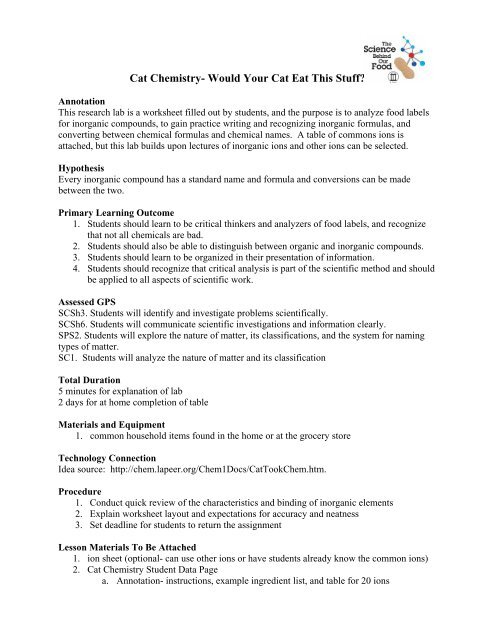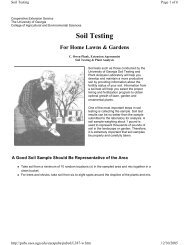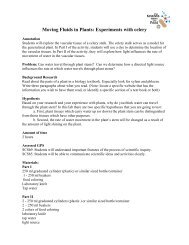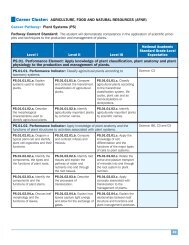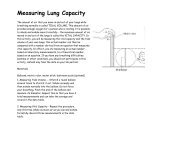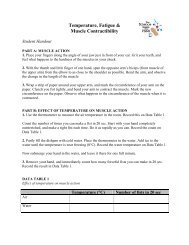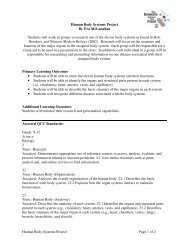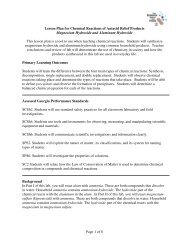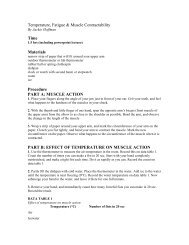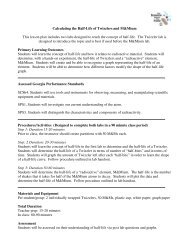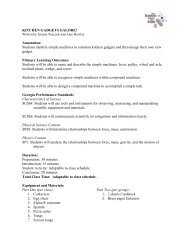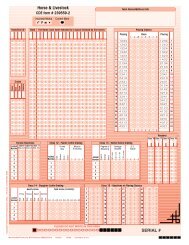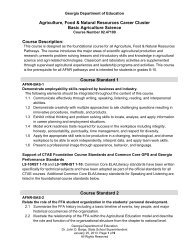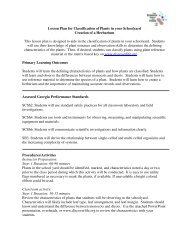Cat Chemistry- Would Your Cat Eat This Stuff?
Cat Chemistry- Would Your Cat Eat This Stuff?
Cat Chemistry- Would Your Cat Eat This Stuff?
Create successful ePaper yourself
Turn your PDF publications into a flip-book with our unique Google optimized e-Paper software.
<strong>Cat</strong> <strong>Chemistry</strong>- <strong>Would</strong> <strong>Your</strong> <strong>Cat</strong> <strong>Eat</strong> <strong>This</strong> <strong>Stuff</strong>?Annotation<strong>This</strong> research lab is a worksheet filled out by students, and the purpose is to analyze food labelsfor inorganic compounds, to gain practice writing and recognizing inorganic formulas, andconverting between chemical formulas and chemical names. A table of commons ions isattached, but this lab builds upon lectures of inorganic ions and other ions can be selected.HypothesisEvery inorganic compound has a standard name and formula and conversions can be madebetween the two.Primary Learning Outcome1. Students should learn to be critical thinkers and analyzers of food labels, and recognizethat not all chemicals are bad.2. Students should also be able to distinguish between organic and inorganic compounds.3. Students should learn to be organized in their presentation of information.4. Students should recognize that critical analysis is part of the scientific method and shouldbe applied to all aspects of scientific work.Assessed GPSSCSh3. Students will identify and investigate problems scientifically.SCSh6. Students will communicate scientific investigations and information clearly.SPS2. Students will explore the nature of matter, its classifications, and the system for namingtypes of matter.SC1. Students will analyze the nature of matter and its classificationTotal Duration5 minutes for explanation of lab2 days for at home completion of tableMaterials and Equipment1. common household items found in the home or at the grocery storeTechnology ConnectionIdea source: http://chem.lapeer.org/Chem1Docs/<strong>Cat</strong>TookChem.htm.Procedure1. Conduct quick review of the characteristics and binding of inorganic elements2. Explain worksheet layout and expectations for accuracy and neatness3. Set deadline for students to return the assignmentLesson Materials To Be Attached1. ion sheet (optional- can use other ions or have students already know the common ions)2. <strong>Cat</strong> <strong>Chemistry</strong> Student Data Pagea. Annotation- instructions, example ingredient list, and table for 20 ions
AssessmentWorksheet will be graded based on completeness, neatness and accuracy. Repetitive ions will bededucted from total score, as will organic ions and any elements.ExtensionFor students who readily grasp current concepts, they can also be asked to predict the type ofbond formed and the electron movement.RemediationA list of common ions is attached and can be distributed to these students to remind them of whatinorganic compounds look like.
<strong>Cat</strong> <strong>Chemistry</strong> Student Data PagesInorganic compounds are found in all processed food (for humans and animals), and aregenerally used for flavoring and preservation. The following are the listed ingredients forPuss’n’Boots Pounce shrimp flavor cat treats:Flour, liver, dried whole egg, glycerin, pregelatinized wheat flour, shrimp by-products, wheat gluten, toruladried yeast, calcium sulfate, cheese meal, phosphoric acid, animal at (preserved with butylatedhydroxyanisole, otherwise known as BHA), potassium chloride, salt, potassium sorbate (a preservative), wheatmiddlings, color, choline chloride, calcium carbonate, ferrous sulfate, vitamin E supplement, zinc oxide, BHA(again!), cupric oxide, cobalt carbonate, manganous oxide, vitamin A supplement, potassium iodide, D-calciumpantothenate, vitamin B-12 supplement, vitamin D-3 supplement, water sufficient for processing.Student Procedure1. Look at food labels in the grocery store, drugstore, and at home for inorganic compounds.2. Complete the data table using the ions on the attached sheet.3. The data table should have at least 20 different compounds, not elements.4. Keep data table organized and legible!
NAME:1CHEMICALNAMECHEMICALFORMULAPRODUCTFOUND IN234567891011121314151617181920
Ions List<strong>Cat</strong>ionsIon Formula Ion Formula Ion FormulaAluminum Al +3 Hydrogen H +1 Potassium K +1Ammonium+1NH 4 Magnesium Mg +2 Sodium Na +1Calcium Ca +2 Nickel (II) Ni +2 Zinc Zn +2Monoatomic AnionsBromide Br -1 Fluoride F -1 Oxide O -2Chloride Cl -1 Iodide I -1 Sulfide S -2Polyatomic Anions-1 Hydrogen sulfateAcetate C 2 H 3 O 2(bisulfate)-1HSO 4 Phosphate-3PO 4-1 Hydrogen sulfiteBromate Br0 3(bisulfite)-1HSO 3 Sulfate-2SO 4Carbonate-2CO 3 Hydroxide OH -1 Sulfite-2SO 3Chlorate-1ClO 3 Hypochlorite ClO -1 Tetraborate-4B 4 O 7Hydrogen Carbonate(bicarbonate)-1HCO 3 Nitrate-1NO 3Alternate NamesChromium (II) Chromous Iron (III) Ferric Tin (II) StannousChromium (III) Chromic Manganese (II) Manganous Tin (IV) StannicCopper (I) Cupric Mercury (I) MercurousIron (II) Ferrous Mercury (II) Mercuric


